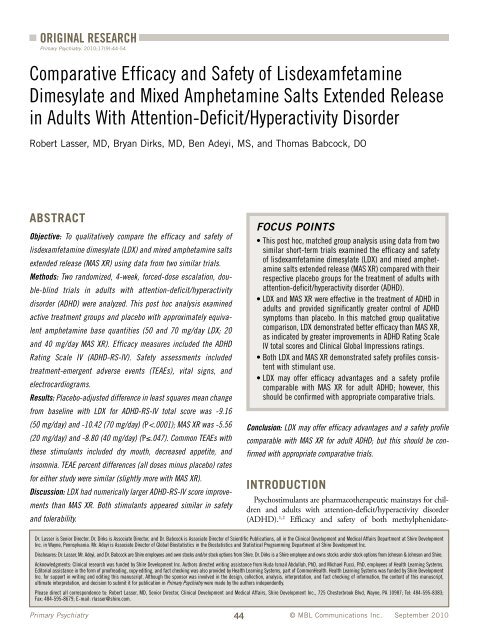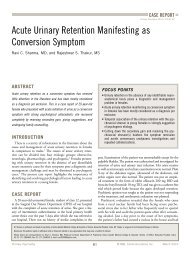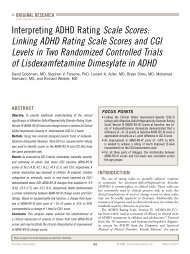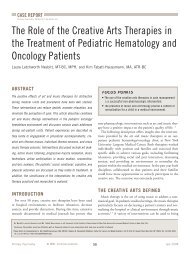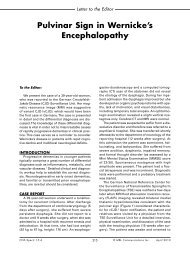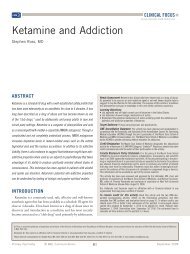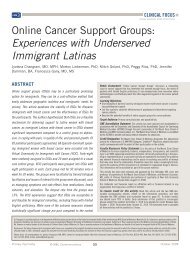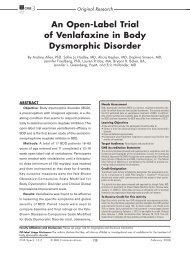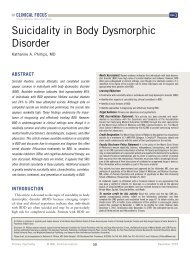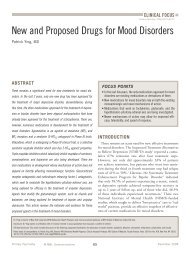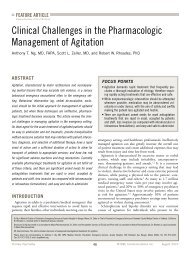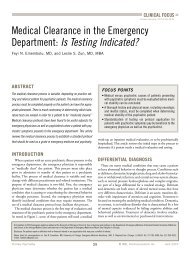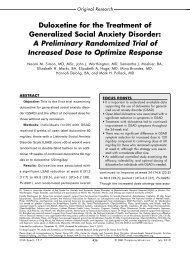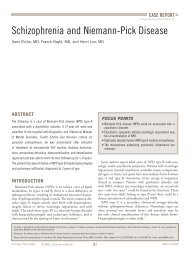Comparative Efficacy and Safety of Lisdexamfetamine Dimesylate ...
Comparative Efficacy and Safety of Lisdexamfetamine Dimesylate ...
Comparative Efficacy and Safety of Lisdexamfetamine Dimesylate ...
Create successful ePaper yourself
Turn your PDF publications into a flip-book with our unique Google optimized e-Paper software.
ORIGINAL RESEARCH<br />
Primary Psychiatry. 2010;17(9):44-54<br />
R. Lasser, B. Dirks, B. Adeyi, T. Babcock<br />
<strong>Comparative</strong> <strong>Efficacy</strong> <strong>and</strong> <strong>Safety</strong> <strong>of</strong> <strong>Lisdexamfetamine</strong><br />
<strong>Dimesylate</strong> <strong>and</strong> Mixed Amphetamine Salts Extended Release<br />
in Adults With Attention-Deficit/Hyperactivity Disorder<br />
Robert Lasser, MD, Bryan Dirks, MD, Ben Adeyi, MS, <strong>and</strong> Thomas Babcock, DO<br />
ABSTRACT<br />
Objective: To qualitatively compare the efficacy <strong>and</strong> safety <strong>of</strong><br />
lisdexamfetamine dimesylate (LDX) <strong>and</strong> mixed amphetamine salts<br />
extended release (MAS XR) using data from two similar trials.<br />
Methods: Two r<strong>and</strong>omized, 4-week, forced-dose escalation, dou-<br />
ble-blind trials in adults with attention-deficit/hyperactivity<br />
disorder (ADHD) were analyzed. This post hoc analysis examined<br />
active treatment groups <strong>and</strong> placebo with approximately equiva-<br />
lent amphetamine base quantities (50 <strong>and</strong> 70 mg/day LDX; 20<br />
<strong>and</strong> 40 mg/day MAS XR). <strong>Efficacy</strong> measures included the ADHD<br />
Rating Scale IV (ADHD-RS-IV). <strong>Safety</strong> assessments included<br />
treatment-emergent adverse events (TEAEs), vital signs, <strong>and</strong><br />
electrocardiograms.<br />
Results: Placebo-adjusted difference in least squares mean change<br />
from baseline with LDX for ADHD-RS-IV total score was -9.16<br />
(50 mg/day) <strong>and</strong> -10.42 (70 mg/day) ( P
(MPH) <strong>and</strong> d-amphetamine-based stimulants were demonstrated<br />
in controlled clinical trials. 2-4 Although efficacy <strong>and</strong><br />
tolerability pr<strong>of</strong>iles <strong>of</strong> both preparations share a high degree <strong>of</strong><br />
similarity, 2 subtle differences exist. 5 Their putative mechanisms<br />
<strong>of</strong> action differ <strong>and</strong> individuals may exhibit different responses to<br />
both stimulants, 2,5,6 suggesting an alternative formulation could<br />
be prescribed for subjects responding inadequately to one. 1<br />
Long-acting formulations generally have similar efficacy <strong>and</strong> tolerability<br />
versus multidose immediate-release (IR) stimulants. 2,4,7,8<br />
Once-daily dosing with long-acting formulations may enhance<br />
convenience <strong>and</strong> adherence 2,4 as well as decrease potential abuse<br />
<strong>and</strong> diversion. 4,9-12 <strong>Comparative</strong> data evaluating long-acting formulations<br />
for ADHD treatment are limited, especially in adults.<br />
Pelham <strong>and</strong> colleagues 6 evaluated relative efficacies <strong>of</strong> four formulations<br />
in children, including sustained-release MPH <strong>and</strong><br />
d-amphetamine formulations. Another pediatric ADHD study<br />
compared efficacy <strong>and</strong> safety <strong>of</strong> lisdexamfetamine dimesylate<br />
(LDX) versus placebo with mixed amphetamine salts extended<br />
release (MAS XR) as a reference arm (eg, no direct comparison<br />
with LDX). 13 Several clinical trials 14-19 compared efficacy <strong>of</strong> different<br />
long-acting MPH formulations in children, but the authors <strong>of</strong><br />
this article are unaware <strong>of</strong> comparative efficacy trials <strong>of</strong> stimulants<br />
in adults. Direct head-to-head trials are required for clinicians to<br />
comprehensively compare long-acting formulations, but in their<br />
absence, we can only rely on indirect, qualitative comparisons.<br />
LDX is a long-acting, amphetamine-based stimulant approved<br />
for ADHD in adults. LDX is the first prodrug stimulant. After<br />
oral ingestion, therapeutically inactive LDX is converted to llysine<br />
<strong>and</strong> active d-amphetamine, which is responsible for the<br />
therapeutic effect. The conversion <strong>of</strong> LDX into active d-amphetamine<br />
occurs primarily in the blood. The combination <strong>of</strong> l-lysine<br />
<strong>and</strong> d-amphetamine created a new chemical entity with a prodrug<br />
technology <strong>of</strong> delivery <strong>of</strong> d-amphetamine. 20 In adults, LDX<br />
demonstrated significant efficacy versus placebo in a 4-week<br />
pivotal trial, 21 <strong>and</strong> from 2–14 hours post dose in a r<strong>and</strong>omized,<br />
controlled, simulated workplace environment trial. 22<br />
MAS XR is also a long-acting, amphetamine-based stimulant<br />
approved for ADHD in adults. 23 MAS XR is a once-daily,<br />
extended-release, single-entity amphetamine product that contains<br />
equal proportions <strong>of</strong> IR <strong>and</strong> enteric-coated delayed-release<br />
beads. 24 The capsule contains two types <strong>of</strong> drug-containing beads<br />
that were designed to give double-pulsed delivery <strong>of</strong> amphetamine<br />
to prolong release. 23 MAS XR has demonstrated efficacy<br />
with various doses versus placebo in a 4-week, r<strong>and</strong>omized trial 25<br />
<strong>and</strong> in a laboratory school study 26 in children from 1.5–12 hours<br />
post dose. A classroom, crossover children’s study indicated that<br />
the percent coefficient <strong>of</strong> variance for T max, C max, <strong>and</strong> area under<br />
the curve-last for LDX-treated subjects was lower than those for<br />
MAS XR-treated subjects, suggesting lower intersubject variability<br />
with LDX <strong>and</strong> potentially more consistent drug delivery<br />
among subjects. 13 Both treatments demonstrated a safety pr<strong>of</strong>ile<br />
consistent with long-acting stimulant use. 4,21,27,28<br />
<strong>Comparative</strong> <strong>Efficacy</strong> <strong>and</strong> <strong>Safety</strong> <strong>of</strong> LDX <strong>and</strong> MAS XR in Adults With ADHD<br />
LDX <strong>and</strong> MAS XR are controlled substances <strong>and</strong> carry warnings<br />
for potential abuse. Head-to-head abuse liability studies<br />
have not been conducted between the products. Oral LDX<br />
capsules contain no free d-amphetamine <strong>and</strong> are not likely<br />
affected by simple mechanical manipulation (eg, crushing <strong>and</strong><br />
simple extraction). 29 In contrast, mechanical manipulation may<br />
be possible with beaded technology, such as MAS XR, in which<br />
active d- <strong>and</strong> l-amphetamine are contained in the capsule <strong>and</strong><br />
can be made accessible. Oral <strong>and</strong> intravenous (IV) abuse liability<br />
studies have been conducted with LDX only, 29,30 <strong>and</strong> not with<br />
MAS XR; therefore, no definitive conclusions can be made<br />
regarding comparative abuse-related drug-liking effect between<br />
these two treatments. However, unlike IR d-amphetamine, IV<br />
LDX did not produce significant subjective abuse-related liking<br />
in adult substance abusers compared with placebo. 30 LDX<br />
(50 <strong>and</strong> 100 mg) taken orally had reduced abuse-related liking<br />
effects compared with IR d-amphetamine (40 mg equivalent<br />
amphetamine-base dose to LDX 100 mg). At higher doses <strong>of</strong><br />
LDX (150 mg), subject abuse-related liking scores were similar<br />
between LDX <strong>and</strong> IR d-amphetamine (40 mg). 29<br />
Absence <strong>of</strong> direct head-to-head data motivated the present<br />
post hoc analysis <strong>of</strong> matched groups that qualitatively explores<br />
the safety <strong>and</strong> efficacy <strong>of</strong> both stimulants using data from two<br />
separate clinical trials in adults. 21,25 This qualitative assessment<br />
was designed to compare the efficacy <strong>and</strong> safety pr<strong>of</strong>iles <strong>of</strong><br />
LDX <strong>and</strong> MAS XR in a short-term, r<strong>and</strong>omized, placebo-<br />
controlled clinical trial setting.<br />
METHODS<br />
Study Designs<br />
The study designs <strong>of</strong> both clinical trials in the present analysis<br />
have been described previously. 21,25 Briefly, both were multicenter,<br />
r<strong>and</strong>omized, double-blind, placebo-controlled, parallel-group,<br />
forced-dose escalation clinical trials. At baseline, subjects were<br />
r<strong>and</strong>omized to receive stimulant (one <strong>of</strong> three dosages <strong>of</strong> LDX<br />
or MAS XR) or placebo <strong>and</strong> began a 4-week treatment period.<br />
In the LDX trial, subjects r<strong>and</strong>omized to receive active treatment<br />
(LDX 30, 50, or 70 mg/day) initiated therapy at 30 mg/day<br />
with weekly adjustment to r<strong>and</strong>omized dose. In the MAS XR<br />
clinical trial, subjects r<strong>and</strong>omized to receive active treatment<br />
(MAS XR 20, 40, or 60 mg/day) initiated therapy at 20 mg/day<br />
with weekly adjustment to their r<strong>and</strong>omized dose.<br />
Subjects<br />
Each clinical trial enrolled adults who met Diagnostic <strong>and</strong><br />
Statistical Manual <strong>of</strong> Mental Disorders, Fourth Edition, Text<br />
Revision, 31 criteria for a primary diagnosis <strong>of</strong> ADHD. In the<br />
LDX trial, subjects were required to be 18–55 years <strong>of</strong> age,<br />
Primary Psychiatry 45<br />
© MBL Communications Inc. September 2010
R. Lasser, B. Dirks, B. Adeyi, T. Babcock<br />
whereas in the MAS XR trial only a lower age limit <strong>of</strong> 18 years<br />
was specified. Exclusion criteria in both trials included comorbid<br />
psychiatric conditions with significant symptoms, pregnancy,<br />
seizures, tic disorders, Tourette’s syndrome, hypertension, cardiac<br />
conditions, a positive drug screen, history <strong>of</strong> substance abuse, or<br />
use <strong>of</strong> any prescription/investigational medication (except that<br />
used to treat ADHD within 30 days <strong>of</strong> screening). Each study<br />
relied on clinical diagnosis <strong>of</strong> ADHD based on a structured diagnostic<br />
interview. The LDX study had the additional requirement<br />
that a baseline severity in clinician-rated ADHD Rating Scale IV<br />
(ADHD-RS-IV) be met for entry. The present analyses included<br />
only data from a subgroup <strong>of</strong> enrolled subjects in each trial who<br />
were matched for baseline ADHD severity <strong>and</strong> r<strong>and</strong>omized<br />
to approximately equivalent doses <strong>of</strong> delivered amphetamine<br />
base content. Subjects in the MAS XR study with baseline<br />
ADHD-RS-IV total scores
using the MedDRA dictionary (Version 9.1) <strong>and</strong> reporting all<br />
TEAEs with a subject incidence ≥5%, using MedDRA preferred<br />
terminology. Vital signs were summarized by treatment group.<br />
Categorical analysis using outlier criteria was performed for SBP<br />
(≥150 mm Hg), DBP (≥95 mm Hg), pulse (change to ≥ mean+2<br />
SD), QT interval (>480 msec), <strong>and</strong> QT interval corrected using<br />
Fridericia’s formula (QTcF; >480 msec).<br />
RESULTS<br />
Subject Demographics<br />
Using the above selection criteria, the LDX trial comprised<br />
301 subjects, including 239 r<strong>and</strong>omized to receive LDX. In<br />
the MAS XR trial data set, 128 subjects were included, with 83<br />
r<strong>and</strong>omized to receive MAS XR. All subjects enrolled <strong>and</strong> r<strong>and</strong>omized<br />
for this subgroup analysis were included in the safety<br />
analysis. Within each trial, the demographic characteristics <strong>of</strong><br />
the subjects were similar (Table 1). The mean age <strong>of</strong> subjects<br />
in the LDX clinical trial was slightly younger than those in the<br />
<strong>Comparative</strong> <strong>Efficacy</strong> <strong>and</strong> <strong>Safety</strong> <strong>of</strong> LDX <strong>and</strong> MAS XR in Adults With ADHD<br />
MAS XR trial. The proportion <strong>of</strong> men in each treatment group<br />
in the LDX trial (51.6%–56.4%) was slightly less than that<br />
observed in the MAS XR trial (59.5%–70.7%).<br />
<strong>Efficacy</strong><br />
TABLE 1<br />
DEMOGRAPHIC CHARACTERISTICS OF SUBJECTS FROM LDX AND MAS XR TRIALS<br />
LDX 50 mg/day<br />
(n=117)<br />
Within each study, active treatment groups <strong>and</strong> placebo exhibited<br />
similar mean baseline ADHD-RS-IV total scores, although baseline<br />
scores in the LDX clinical trial were slightly higher than those in<br />
the MAS XR trial <strong>and</strong> endpoint scores were decreased versus baseline<br />
in both trials (Figure 1). In each clinical trial, active treatment<br />
was associated with significantly greater improvements from baseline<br />
in ADHD-RS-IV total score at endpoint (last valid postbaseline<br />
assessment) than placebo (Figure 2). Moreover, within these<br />
subgroups, the placebo-adjusted least squares mean (SE) ADHD-<br />
RS-IV total score change from baseline at endpoint for the placebo<br />
cohorts was -8.1 (1.40) <strong>and</strong> -7.4 (1.89) in the LDX <strong>and</strong> MAS XR<br />
trials, respectively. The ADHD-RS-IV treatment effect size was<br />
larger for both LDX doses when compared with approximately<br />
equivalent doses <strong>of</strong> MAS XR (Table 2); however, no statistical<br />
comparisons were performed.<br />
LDX Trial MAS XR Trial<br />
LDX 70 mg/day<br />
(n=122) Placebo (n=62)<br />
MAS XR<br />
20 mg/day (n=41)<br />
MAS XR<br />
40 mg/day (n=42) Placebo (n=45)<br />
Age (years) mean (SD) 34.2 (10.0) 35.8 (10.5) 35.2 (10.9) 38.9 (11.5) 37.3 (10.0) 39.6 (11.8)<br />
Age category (years), n (%)<br />
18-29<br />
30-39<br />
40-49<br />
≥50<br />
Sex, n (%)<br />
Male<br />
Female<br />
Ethnicity/race, n (%)<br />
White<br />
Black<br />
Hispanic<br />
Asian<br />
Native American<br />
Other<br />
45 (38.5)<br />
31 (26.5)<br />
33 (28.2)<br />
8 (6.8)<br />
66 (56.4)<br />
51 (43.6)<br />
99 (84.6)<br />
3 (2.6)<br />
11 (9.4)<br />
2 (1.7)<br />
1 (0.9)<br />
1 (0.9)<br />
40 (32.8)<br />
37 (30.3)<br />
31 (25.4)<br />
14 (11.5)<br />
63 (51.6)<br />
59 (48.4)<br />
108 (88.5)<br />
2 (1.6)<br />
8 (6.6)<br />
1 (0.8)<br />
0<br />
3 (2.5)<br />
22 (35.5)<br />
15 (24.2)<br />
19 (30.6)<br />
6 (9.7)<br />
32 (51.6)<br />
30 (48.4)<br />
48 (77.4)<br />
4 (6.5)<br />
6 (9.7)<br />
0<br />
2 (3.2)<br />
2 (3.2)<br />
10 (24.4)<br />
12 (29.3)<br />
11 (26.8)<br />
8 (19.5)<br />
29 (70.7)<br />
12 (29.3)<br />
36 (87.8)<br />
2 (4.9)<br />
2 (4.9)<br />
1 (2.4)<br />
0<br />
0<br />
11 (26.2)<br />
15 (35.7)<br />
11 (26.2)<br />
5 (11.9)<br />
25 (59.5)<br />
17 (40.5)<br />
38 (90.5)<br />
1 (2.4)<br />
2 (4.8)<br />
0<br />
1 (2.4)<br />
0<br />
10 (22.2)<br />
12 (26.7)<br />
14 (31.1)<br />
9 (20.0)<br />
29 (64.4)<br />
16 (35.6)<br />
39 (86.7)<br />
2 (4.4)<br />
2 (4.4)<br />
1 (2.2)<br />
0<br />
1 (2.2)<br />
Weight (lb) mean (SD) 173.1 (37.8) 174.3 (37.3) 181.3 (39.1) 183.9 (31.8) 185.6 (55.3) 186.3 (42.6)<br />
Height (in) mean (SD) 67.6 (3.6) 67.4 (3.7) 67.9 (3.7) 68.2 (3.5) 67.5 (3.7) 67.7 (4.0)<br />
ITT population, n 117 120 62 39 42 43<br />
<strong>Safety</strong> population, n 117 122 62 41 42 45<br />
LDX=lisdexamfetamine dimesylate; MAS XR=mixed amphetamine salts extended release; SD=st<strong>and</strong>ard deviation; ITT=intention to treat.<br />
Lasser R, Dirks B, Adeyi B, Babcock T. Primary Psychiatry. Vol 17, No 9. 2010.<br />
Primary Psychiatry 47<br />
© MBL Communications Inc. September 2010
R. Lasser, B. Dirks, B. Adeyi, T. Babcock<br />
In the LDX trial, subjects r<strong>and</strong>omized to the placebo<br />
group had a mean (SD) baseline CGI-S score <strong>of</strong> 4.7 (.73)<br />
<strong>and</strong> in the MAS XR trial a score <strong>of</strong> 4.6 (.62). On the CGI-S<br />
scale, a score <strong>of</strong> 4 represents “moderately ill” while a score <strong>of</strong><br />
5 represents “markedly ill.” 35 In the LDX trial at endpoint,<br />
Dunnett test determined that the mean (SD) CGI-I scores<br />
FIGURE 1<br />
MEAN (SD) ADHD-RS-IV SCORES AT BASELINE AND ENDPOINT*<br />
Mean (SD) ADHD-RS-IV Total Score<br />
54<br />
48<br />
42<br />
36<br />
30<br />
24<br />
18<br />
12<br />
6<br />
0<br />
LDX<br />
50 mg/day<br />
LDX Placebo MAS XR MAS XR Placebo<br />
70 mg/day<br />
20 mg/day 40 mg/day<br />
LDX Study MAS XR Study<br />
* Endpoint=last valid postbaseline assessment.<br />
ADHD-RS-IV=Attention-Deficit/Hyperactivity Disorder Rating Scale IV; LDX=lisdexamfetamine<br />
dimesylate; MAS XR=mixed amphetamine salts extended release.<br />
Baseline Endpoint<br />
Lasser R, Dirks B, Adeyi B, Babcock T. Primary Psychiatry. Vol 17, No 9. 2010.<br />
were significantly lower (indicating greater improvement) for<br />
both LDX dose groups compared with 3.2 (1.19) in the placebo<br />
group (P
significantly lower in both MAS XR groups compared with<br />
3.4 (1.00) in the placebo group (P≤.0027; Table 2). Effect sizes<br />
for treatment with LDX <strong>and</strong> MAS XR as assessed by the global<br />
improvement scales are presented in Table 2.<br />
In the LDX trial, a post hoc analysis <strong>of</strong> dichotomized CGI-I<br />
difference in improved (very much improved [CGI-I=1] <strong>and</strong><br />
much improved [CGI-I=2]) versus placebo was significant for<br />
both doses <strong>of</strong> LDX, at all weeks <strong>and</strong> at endpoint (P≤.0005 for<br />
each). The percentage <strong>of</strong> subjects for 50 <strong>and</strong> 70 mg/day LDX,<br />
respectively, at week 1 was 24.7% <strong>and</strong> 27.9%; at week 2 was<br />
32.5% <strong>and</strong> 34.2%; at week 3 was 35.1% <strong>and</strong> 38.9%; at week 4<br />
was 32.9% <strong>and</strong> 33.3%; <strong>and</strong> at endpoint was 32.5% <strong>and</strong> 31.8%.<br />
For the MAS XR trial, the analysis indicated that the categorical<br />
CGI-I difference in improved versus placebo was not significant<br />
for the 20 mg/day dose <strong>of</strong> MAS XR at all weeks <strong>and</strong> at endpoint.<br />
With the 40 mg/day dose <strong>of</strong> MAS XR, the percentage <strong>of</strong> subjects<br />
that had a difference in improved versus placebo was significant<br />
only at weeks 2 <strong>and</strong> 4, <strong>and</strong> at endpoint (P≤.0210 for each). The<br />
CGI-I difference for the 40 mg/day dose <strong>of</strong> MAS XR at week 2<br />
was 27.3%; at week 4 was 29.2%; <strong>and</strong> at endpoint was 29.1%.<br />
<strong>Safety</strong><br />
The harmonization <strong>of</strong> AE terminology resulted in the reclassification<br />
<strong>of</strong> the verbatim item mapping to the COSTART<br />
“anorexia” to the MedDRA “decreased appetite” or “anorexia.”<br />
The verbatim terms mapping to the COSTART “insomnia” was<br />
TABLE 3<br />
<strong>Comparative</strong> <strong>Efficacy</strong> <strong>and</strong> <strong>Safety</strong> <strong>of</strong> LDX <strong>and</strong> MAS XR in Adults With ADHD<br />
reclassified to the MedDRA “initial insomnia” or “insomnia.”<br />
In the LDX clinical trial, 80.3% <strong>of</strong> subjects in the active treatment<br />
groups experienced at least one TEAE compared with<br />
58.1% <strong>of</strong> those receiving placebo (Table 3). The most common<br />
(≥10%) TEAEs reported by subjects receiving LDX were dry<br />
mouth (28%), decreased appetite (25.5%), headache (21.3%),<br />
<strong>and</strong> insomnia (19.2%). In the MAS XR clinical trial, 80.7% <strong>of</strong><br />
subjects experienced at least one TEAE compared with 53.3%<br />
<strong>of</strong> those receiving placebo. After harmonization, the most common<br />
(≥10%) TEAEs reported by subjects receiving MAS XR<br />
were dry mouth (33.7%), decreased appetite (26.5%), insomnia<br />
(21.7%), headache (20.5%), <strong>and</strong> weight loss (14.5%; Table 4).<br />
The difference in percent incidence <strong>of</strong> all active treatment doses<br />
for either trial minus placebo TEAEs for both stimulants were<br />
dry mouth, decreased appetite, <strong>and</strong> insomnia; MAS XR all doses<br />
included headache <strong>and</strong> weight loss. In the LDX trial 22.2% <strong>of</strong><br />
subjects <strong>and</strong> in the MAS XR trial 27.4% <strong>of</strong> subjects experienced<br />
at least one difference in percent incidence <strong>of</strong> all active treatment<br />
doses minus placebo TEAEs. In both trials, most TEAEs<br />
were mild or moderate in severity. Severe TEAEs were reported<br />
by 4.2% (n=10) <strong>of</strong> subjects receiving LDX, with only severe<br />
fatigue (n=2; 0.8%) <strong>and</strong> severe insomnia (n=6; 2.5%) reported<br />
by more than one subject. Among subjects receiving MAS XR,<br />
8.4% (n=7) experienced severe TEAEs, with only severe insomnia<br />
reported by more than one subject (n=3; 3.6%).<br />
Both stimulants were associated with small mean increases<br />
from baseline in SBP at endpoint (Table 5). LDX-treated<br />
TEAES REPORTED DURING LDX TRIAL BY ≥5% OF SUBJECTS IN EITHER LDX TREATMENT GROUP<br />
Body System Preferred Term<br />
(MedDRA 9.1)<br />
LDX 50 mg/day<br />
(n=117) n (%)<br />
LDX 70 mg/day<br />
(n=122) n (%)<br />
All LDX Doses<br />
(n=239) n (%)<br />
Placebo<br />
(n=62) n (%)<br />
Difference in % Incidence <strong>of</strong> All LDX<br />
Doses Minus Placebo (%)<br />
Any TEAE 90 (76.9) 102 (83.6) 192 (80.3) 36 (58.1) 22.2<br />
Anorexia 8 (6.8) 6 (4.9) 14 (5.9) 0 5.9<br />
Anxiety 7 (6.0) 9 (7.4) 16 (6.7) 0 6.7<br />
Decreased appetite 33 (28.2) 28 (23.0) 61 (25.5) 1 (1.6) 23.9<br />
Diarrhea 12 (10.3) 4 (3.3) 16 (6.7) 0 6.7<br />
Dry mouth 29 (24.8) 38 (31.1) 67 (28.0) 2 (3.2) 24.8<br />
Feeling jittery 4 (3.4) 9 (7.4) 13 (5.4) 0 5.4<br />
Headache 22 (18.8) 29 (23.8) 51 (21.3) 8 (12.9) 8.4<br />
Initial insomnia 7 (6.0) 7 (5.7) 14 (5.9) 2 (3.2) 2.7<br />
Insomnia 20 (17.1) 26 (21.3) 46 (19.2) 3 (4.8) 14.4<br />
Irritability 6 (5.1) 7 (5.7) 13 (5.4) 4 (6.5) -1.1<br />
Nausea 7 (6.0) 8 (6.6) 15 (6.3) 0 6.3<br />
Upper abdominal pain 7 (6.0) 1 (0.8) 8 (3.3) 1 (1.6) 1.7<br />
Upper respiratory tract infection 6 (5.1) 7 (5.7) 13 (5.4) 3 (4.8) 0.6<br />
TEAEs=treatment-emergent adverse events; LDX=lisdexamfetamine dimesylate; MedDRA=Medical Dictionary for Regulatory Activities.<br />
Lasser R, Dirks B, Adeyi B, Babcock T. Primary Psychiatry. Vol 17, No 9. 2010.<br />
Primary Psychiatry 49<br />
© MBL Communications Inc. September 2010
R. Lasser, B. Dirks, B. Adeyi, T. Babcock<br />
subjects had a mean (SD) SBP increase from baseline at endpoint<br />
<strong>of</strong> 0.7 (9.2) mm Hg. At endpoint, subjects treated with<br />
MAS XR demonstrated a mean (SD) change in SBP from<br />
baseline <strong>of</strong> 2.1 (12.9) mm Hg. The maximum mean (SD)<br />
changes from baseline in SBP for the active treatment<br />
groups occurred at week 3 for LDX (1.5 [9.7] mm Hg)<br />
<strong>and</strong> at week 4 for MAS XR (2.2 [13.1] mm Hg). In their<br />
respective trials, both LDX <strong>and</strong> MAS XR were also associated<br />
with small mean increases from baseline in DBP at<br />
endpoint (Table 5). At endpoint, subjects treated with LDX<br />
exhibited a mean (SD) increase in DBP <strong>of</strong> 1.3 (7.5) mm<br />
Hg compared with 3.6 (9.9) mm Hg exhibited by MAS<br />
XR-treated subjects. The maximum mean (SD) change from<br />
baseline in DBP occurred at week 2 for LDX-treated subjects<br />
(1.9 [7.0] mm Hg) <strong>and</strong> at week 4 for MAS XR-treated<br />
subjects (3.6 [10.0] mm Hg). The lower dose <strong>of</strong> LDX (ie,<br />
50 mg) was actually associated with a mean (SD) 0.3 (9.1) mm<br />
Hg decrease in SBP, while both doses <strong>of</strong> MAS XR were associated<br />
with increases in SBP at endpoint. Similarly, while both<br />
stimulants resulted in minimal increases in DBP at endpoint,<br />
the mean (SD) elevations associated with 70 mg/day LDX were<br />
~2.5 times less than observed in subjects receiving 40 mg/day<br />
MAS XR (1.7 [6.9] mm Hg versus 4.3 [8.7] mm Hg).<br />
In both trials, stimulant treatment was associated with mean<br />
increases in pulse (Table 5). The placebo-treated cohorts demonstrated<br />
virtually no mean (SD) change in pulse from baseline at<br />
TABLE 4<br />
endpoint: 0 (9.2) beats per minute (bpm) <strong>and</strong> 0.4 (11.3) bpm<br />
for placebo cohorts in the LDX <strong>and</strong> MAS XR trials, respectively.<br />
At endpoint, LDX <strong>and</strong> MAS XR were associated with mean<br />
(SD) increases in pulse <strong>of</strong> 4.6 (10.7) bpm <strong>and</strong> 4.9 (11.4) bpm,<br />
respectively. For the combined active treatment groups, the<br />
maximal mean (SD) increases in pulse were observed at week 3:<br />
5.7 (10.4) bpm for LDX <strong>and</strong> 6.0 (13.5) bpm for MAS XR.<br />
Overall, participants rarely met outlier criteria (Table 6).<br />
Blood pressure (BP) outlier criteria were not met at endpoint<br />
by any subject receiving LDX. Moreover, no subject in the<br />
present analysis had a QT or QTcF interval >480 msec at<br />
any LDX or MAS XR treatment week, nor did any subject<br />
demonstrate a prolongation <strong>of</strong> QTcF <strong>of</strong> 60 msec or more from<br />
baseline at any study week.<br />
Consistent with the short-term safety pr<strong>of</strong>ile <strong>of</strong> stimulants,<br />
in the present analysis both LDX <strong>and</strong> MAS XR were associated<br />
with dose-dependent decreases in weight. In the LDX trial,<br />
subjects receiving placebo exhibited a mean (SD) increase in<br />
weight from baseline <strong>of</strong> 0.4 (2.9) lb at endpoint. In contrast,<br />
subjects receiving 50 <strong>and</strong> 70 mg LDX exhibited mean (SD)<br />
changes in weight <strong>of</strong> -3.1 (6.5) lb <strong>and</strong> -4.3 (4.5) lb, respectively.<br />
At endpoint <strong>of</strong> the MAS XR trial, the mean (SD) change in<br />
weight from baseline was -2.1 (4.0) lb <strong>and</strong> -6.4 (4.9) lb in the<br />
20 <strong>and</strong> 40 mg/day dose groups, respectively, compared with<br />
0.4 (4.9) lb increase in the placebo group.<br />
TEAES REPORTED DURING MAS XR TRIAL BY ≥5% OF SUBJECTS IN EITHER MAS XR TREATMENT GROUP<br />
Body System Preferred Term<br />
(MedDRA 9.1)<br />
MAS XR 20 mg/day<br />
(n=41) n (%)<br />
MAS XR 40 mg/day<br />
(n=42) n (%)<br />
All MAS XR Doses<br />
(n=83) n (%)<br />
Placebo<br />
(n=45) n (%)<br />
Difference in % Incidence <strong>of</strong> All<br />
MAS XR Doses Minus Placebo (%)<br />
Any TEAE 32 (78.0) 35 (83.3) 67 (80.7) 24 (53.3) 27.4<br />
Agitation 3 (7.3) 2 (4.8) 5 (6.0) 1 (2.2) 3.8<br />
Anorexia 0 3 (7.1) 3 (3.6) 0 3.6<br />
Anxiety 4 (9.8) 2 (4.8) 6 (7.2) 3 (6.7) 0.5<br />
Decreased appetite 9 (22.0) 13 (31.0) 22 (26.5) 1 (2.2) 24.3<br />
Diarrhea 3 (7.3) 3 (7.1) 6 (7.2) 0 7.2<br />
Dizziness 2 (4.9) 3 (7.1) 5 (6.0) 0 6.0<br />
Dry mouth 10 (24.4) 18 (42.9) 28 (33.7) 3 (6.7) 27.0<br />
Fatigue 2 (4.9) 3 (7.1) 5 (6.0) 3 (6.7) -0.7<br />
Headache 7 (17.1) 10 (23.8) 17 (20.5) 3 (6.7) 13.8<br />
Initial insomnia 3 (7.3) 2 (4.8) 5 (6.0) 0 6.0<br />
Insomnia 10 (24.4) 8 (19.0) 18 (21.7) 4 (8.9) 12.8<br />
Irritability 2 (4.9) 1 (2.4) 3 (3.6) 5 (11.1) -7.5<br />
Palpitation 4 (9.8) 1 (2.4) 5 (6.0) 0 6.0<br />
Weight loss 3 (7.3) 9 (21.4) 12 (14.5) 0 14.5<br />
TEAEs=treatment-emergent adverse events; MAS XR=mixed amphetamine salts extended release; MedDRA=Medical Dictionary for Regulatory Activities.<br />
Lasser R, Dirks B, Adeyi B, Babcock T. Primary Psychiatry. Vol 17, No 9. 2010.<br />
Primary Psychiatry 50<br />
© MBL Communications Inc. September 2010
DISCUSSION<br />
This study is the first to qualitatively assess two long-acting,<br />
amphetamine-based stimulants, LDX <strong>and</strong> MAS XR, in<br />
adults. Using groups derived from registration trials that were<br />
matched on baseline severity <strong>of</strong> ADHD symptoms, duration<br />
<strong>of</strong> treatment, <strong>and</strong> approximately comparable amphetamine<br />
doses, a post hoc matched-group assessment was conducted.<br />
In these clinical trials, LDX <strong>and</strong> MAS XR had similar TEAEs.<br />
Common TEAEs ≥10% in the present analysis <strong>of</strong> both studies<br />
included dry mouth, decreased appetite, insomnia, <strong>and</strong><br />
headache. The common differences <strong>of</strong> the percent incidence<br />
<strong>of</strong> all active treatment doses minus placebo TEAEs in both trials<br />
were decreased appetite, insomnia, <strong>and</strong> dry mouth. These<br />
are consistent with TEAEs observed with other long-acting<br />
stimulants in adults. 39,40 Although most TEAEs in both clini-<br />
TABLE 5<br />
MEAN (SD) SBP, DBP, AND PULSE AT BASELINE AND AT ENDPOINT*<br />
Vital Sign, mean (SD)<br />
LDX<br />
50 mg/day (n=117)<br />
<strong>Comparative</strong> <strong>Efficacy</strong> <strong>and</strong> <strong>Safety</strong> <strong>of</strong> LDX <strong>and</strong> MAS XR in Adults With ADHD<br />
cal trials were mild or moderate in severity, the incidence <strong>of</strong><br />
severe TEAEs was twice as low in LDX-treated subjects than in<br />
MAS XR-treated subjects. As expected for stimulant therapies,<br />
LDX <strong>and</strong> MAS XR were associated with weight loss over a<br />
4-week treatment period. The degree <strong>of</strong> weight loss was lower<br />
in LDX treatment groups versus MAS XR treatment groups<br />
when assessing groups with approximately equivalent amounts<br />
<strong>of</strong> amphetamine base. Within each trial, the degree <strong>of</strong> weight<br />
loss appeared to demonstrate a dose response.<br />
Although LDX <strong>and</strong> MAS XR were associated with increases<br />
in BP parameters <strong>and</strong> pulse, such changes were modest <strong>and</strong> not<br />
clinically meaningful. Given that the doses <strong>of</strong> LDX <strong>and</strong> MAS<br />
XR included in the present analysis have approximately equivalent<br />
amounts <strong>of</strong> amphetamine base, the mechanisms underlying<br />
the observed differences in cardiovascular effects are unclear.<br />
Subgroup post hoc analysis results for vital signs (SBP, DBP,<br />
LDX Trial MAS XR Trial<br />
LDX<br />
70 mg/day (n=122) Placebo (n=62)<br />
MAS XR<br />
20 mg/day (n=41)<br />
MAS XR<br />
40 mg/day (n=42) Placebo (n=45)<br />
SBP, mm Hg Baseline 118.3 (9.8) 115.5 (10.0) 116.4 (10.3) 121.3 (10.8) 117.4 (13.5) 117.4 (10.7)<br />
Endpoint 118 (10.0) 117.3 (10.2) 116.0 (10.8) 122.8 (12.3) 120.0 (13.0) 116.6 (10.7)<br />
DBP, mm Hg Baseline 74.8 (8.3) 73.6 (8.1) 74.1 (8.2) 77.6 (8.7) 74.9 (9.8) 76.8 (8.4)<br />
Endpoint 75.7 (8.2) 75.5 (8.5) 75.2 (8.2) 80.6 (9.5) 79.2 (7.6) 79.8 (8.5)<br />
Pulse, bpm Baseline 72.4 (8.9) 69.8 (9.2) 70.9 (9.6) 73.1 (9.5) 73.6 (9.1) 71.8 (8.9)<br />
Endpoint 76.0 (11.5) 75.6 (10.4) 70.9 (8.1) 77.1 (11.1) 79.6 (9.8) 72.2 (9.5)<br />
*Endpoint=last valid postbaseline measurement.<br />
SD=st<strong>and</strong>ard deviation; SBP=systolic blood pressure; DBP=diastolic blood pressure; LDX=lisdexamfetamine dimesylate; MAS XR=mixed amphetamine salts extended release; bpm=beats<br />
per minute.<br />
Lasser R, Dirks B, Adeyi B, Babcock T. Primary Psychiatry. Vol 17, No 9. 2010.<br />
TABLE 6<br />
OUTLIER CRITERIA MET BY PARTICIPANTS AT ENDPOINT*<br />
Outlier Criteria<br />
LDX 50 mg/day<br />
(n=117)<br />
LDX Trial MAS XR Trial<br />
LDX 70 mg/day<br />
(n=122) Placebo (n=62)<br />
MAS XR<br />
20 mg/day (n=41)<br />
MAS XR<br />
40 mg/day (n=42) Placebo (n=45)<br />
SBP ≥150 mm Hg 0 0 0 2 1 0<br />
DBP ≥95 mm Hg 0 0 0 1 0 1<br />
Pulse ≥mean + 2 SD bpm 3 4 3 6 4 3<br />
QT interval >480 msec 0 0 0 0 0 0<br />
QTcF >480 msec 0 0 0 0 0 0<br />
*Endpoint=last valid postbaseline assessment.<br />
LDX=lisdexamfetamine dimesylate; MAS XR=mixed amphetamine salts extended release; SBP=systolic blood pressure; DBP=diastolic blood pressure; SD=st<strong>and</strong>ard deviation;<br />
bpm=beats per minute; QTcF=QT interval corrected using Fridericia’s formula.<br />
Lasser R, Dirks B, Adeyi B, Babcock T. Primary Psychiatry. Vol 17, No 9. 2010.<br />
Primary Psychiatry 51<br />
© MBL Communications Inc. September 2010
R. Lasser, B. Dirks, B. Adeyi, T. Babcock<br />
<strong>and</strong> pulse) from the LDX <strong>and</strong> MAS XR analysis were consistent<br />
with what has been observed in their respective studies; the mean<br />
(SD) change from baseline at endpoint for both LDX <strong>and</strong> MAS<br />
XR were consistent with their respective primary study (data not<br />
shown). Another possibility for the difference was that this post<br />
hoc analysis <strong>of</strong> the selected groups may introduce some bias. A<br />
difference between these agents is the absence <strong>of</strong> l-amphetamine<br />
from LDX <strong>and</strong> its presence in MAS XR (both d- <strong>and</strong> l- is<strong>of</strong>orms),<br />
which may play an essential role in this slight cardiovascular<br />
difference between treatments. 41-43 Studies comparing the<br />
cardiovascular effects <strong>of</strong> d- <strong>and</strong> l-amphetamine have not yielded<br />
clear answers; however, many sources suggest that l-amphetamine<br />
may have greater peripheral <strong>and</strong> cardiovascular effects <strong>and</strong><br />
that d-amphetamine is more potent as a central stimulant. 41,44 In<br />
a small clinical trial in children with ADHD, Arnold <strong>and</strong> colleagues<br />
44 found no significant differences in effects on BP <strong>and</strong><br />
heart rate, but it was also assessed at the third week <strong>of</strong> treatment.<br />
Unlike changes in BP parameters, increases in pulse were very<br />
similar between equivalent (ie, similar total amphetamine base)<br />
doses <strong>of</strong> LDX <strong>and</strong> MAS XR with only minimally higher rates<br />
observed with MAS XR. In neither study did treatment result in<br />
clinically significant changes in QT interval.<br />
Both LDX <strong>and</strong> MAS XR were associated with significant<br />
reductions (versus placebo) in ADHD core symptoms as<br />
assessed by ADHD-RS-IV total scores. Significant improvements<br />
were also observed on clinician ratings <strong>of</strong> global<br />
improvement as assessed by CGI score. At approximately<br />
equivalent amphetamine doses, LDX resulted in numerically<br />
greater improvements in ADHD-RS-IV <strong>and</strong> CGI than MAS<br />
XR. The ADHD-RS-IV treatment effect size <strong>and</strong> CGI-I/CGI-<br />
C was larger for both LDX doses when compared qualitatively<br />
with approximately equivalent doses <strong>of</strong> MAS XR. The ADHD-<br />
RS-IV total score effect sizes suggest that both LDX doses demonstrated<br />
effect sizes that are considered large; effects sizes for<br />
MAS XR were medium. The CGI effect sizes for LDX were<br />
medium <strong>and</strong> large for both LDX doses (50 <strong>and</strong> 70 mg/day),<br />
respectively, <strong>and</strong> medium for both doses <strong>of</strong> MAS XR (20 <strong>and</strong><br />
40 mg/day). These differences in effect sizes may be due to the<br />
relative sample sizes <strong>of</strong> LDX groups that were almost twice as<br />
large as the MAS XR group as well as relative placebo responses<br />
across both studies. When comparing placebo-adjusted<br />
comparisons (eg, effect size) for each stimulant, the reader is<br />
reminded that the placebo cohort used for comparison differed<br />
in each study. While no direct comparisons <strong>of</strong> these placebo<br />
groups were performed, the placebo effect appears greater in<br />
the LDX trial. This was indicated by the greater decrease in<br />
ADHD-RS-IV total score change from baseline at endpoint<br />
for the placebo cohort in the LDX trial. Overall, a qualitative<br />
assessment would imply a slightly better improvement with<br />
LDX versus MAS XR when compared with placebo.<br />
The present analysis suggests that, at approximately comparable<br />
doses, LDX was more efficacious than MAS XR <strong>and</strong><br />
had lower incidence <strong>of</strong> the differences (all active treatment<br />
doses [for either trial] minus placebo) in the percent <strong>of</strong> AEs<br />
<strong>and</strong> any percent differences <strong>of</strong> AEs versus MAS XR, although<br />
prospective <strong>and</strong> quantitative comparison studies are required to<br />
confirm these results. The results <strong>of</strong> this analysis are consistent<br />
with short-term controlled clinical trials evaluating the safety<br />
<strong>and</strong> efficacy <strong>of</strong> LDX <strong>and</strong> MAS XR in children <strong>and</strong> adolescents<br />
with ADHD that also demonstrated significant improvements<br />
versus placebo in both ADHD-RS-IV total score <strong>and</strong> CGI ratings.<br />
28,45 Furthermore, although the present analysis used data<br />
from a pair <strong>of</strong> short-term trials, the effectiveness <strong>of</strong> both LDX<br />
<strong>and</strong> MAS XR for the treatment <strong>of</strong> ADHD in adults has been<br />
demonstrated in long-term trials. 46,47<br />
Other considerations in terms <strong>of</strong> assessing potential differences<br />
between both treatment regimens should be noted. The<br />
mode <strong>of</strong> therapeutic action for amphetamines in the treatment<br />
<strong>of</strong> ADHD is thought to be due to the block <strong>of</strong> reuptake <strong>of</strong><br />
norepinephrine <strong>and</strong> dopamine into the presynaptic neuron<br />
<strong>and</strong> their increased release into the extraneuronal space. LDX,<br />
the parent drug, does not bind to the sites responsible for the<br />
reuptake <strong>of</strong> the neurotransmitters. 48 Thus, although there are<br />
similarities between LDX <strong>and</strong> MAS XR, they are different<br />
in terms <strong>of</strong> mechanism <strong>of</strong> action (prodrug versus mechanical<br />
release) <strong>and</strong> their pharmacokinetic pr<strong>of</strong>iles (LDX has a more<br />
predictable pharmacokinetic pr<strong>of</strong>ile).<br />
Although pharmacokinetic studies <strong>of</strong> MAS XR in adults<br />
indicated consistency in terms <strong>of</strong> bioavailability, 49-51 the prodrug<br />
mechanism <strong>of</strong> LDX may provide a more consistent pharmacokinetic<br />
pr<strong>of</strong>ile. In a clinical trial in healthy adults, LDX demonstrated<br />
low inter- <strong>and</strong> intrasubject variability, <strong>of</strong>fering consistent<br />
time to maximum d-amphetamine concentration. 52 With prodrug<br />
LDX administration, d-amphetamine plasma concentrations<br />
increased linearly <strong>and</strong> in a dose-dependent manner,<br />
with no indication <strong>of</strong> enzyme saturation in healthy adults <strong>and</strong><br />
showed reliable delivery over a wide range <strong>of</strong> doses. 52 The prodrug<br />
mechanism requires intrinsic enzymatic cleavage <strong>of</strong> intact<br />
LDX to active d-amphetamine <strong>and</strong> is independent <strong>of</strong> exogenous<br />
formulation/drug-release delivery systems such as MAS XR. 53<br />
Mechanically formulated delayed-release beads can be crushed,<br />
so they are more easily susceptible to abuse 9 ; enteric-coated beads<br />
can be affected by gastric pH, since they have a pH-sensitive,<br />
release-delaying polymer layer <strong>and</strong> overcoating. 54 Variations in<br />
pH did not affect the solubility pr<strong>of</strong>ile <strong>of</strong> LDX, <strong>and</strong> increases in<br />
pH beyond this range only slightly reduced solubility. 55 Hence,<br />
the absorption <strong>of</strong> LDX versus MAS XR is not readily altered or<br />
converted by enzymes that simulated conditions <strong>of</strong> the gastrointestinal<br />
tract <strong>and</strong> is consistent with intact LDX absorption. 20<br />
It has also been suggested that LDX is absorbed intact by active<br />
transport in the small intestine. 20 Although, changes in urinary<br />
pH alter the elimination <strong>of</strong> either drug, with urinary alkalinization<br />
decreasing excretion <strong>and</strong> acidification increasing excretion,<br />
23,48 d-amphetamine is not available until after metabolism<br />
Primary Psychiatry 52<br />
© MBL Communications Inc. September 2010
<strong>of</strong> LDX. Prescribing information for LDX, unlike that for MAS<br />
XR, does not warn about the effects <strong>of</strong> alterations in gastric pH<br />
on d-amphetamine absorption. 23,48<br />
The findings <strong>of</strong> this matched group qualitative assessment <strong>of</strong><br />
two clinical trials must be viewed in light <strong>of</strong> several limitations.<br />
To develop matched comparison groups, the data set from the<br />
MAS XR trial was reduced in size <strong>and</strong> was smaller than the LDX<br />
data set (n=128 vs. n=301), potentially allowing for variability as<br />
a result <strong>of</strong> differences in sample size, although the original number<br />
<strong>of</strong> participants in the MAS XR trial was ~250. 25 The nature<br />
<strong>of</strong> effect sizes is to estimate the apparent magnitude <strong>of</strong> relationships<br />
among data sets between treatment <strong>and</strong> placebo groups.<br />
As such, effect sizes facilitate comparisons between studies <strong>of</strong><br />
various population sizes, limited study design differences, <strong>and</strong><br />
with similar or different outcome measures. 56 Nonetheless, since<br />
the assessed population <strong>of</strong> the LDX trial was ~2-fold higher,<br />
comparisons <strong>of</strong> study effect sizes <strong>and</strong> the differences between<br />
TEAE frequencies should be considered as qualitative in nature.<br />
Additionally, while the demographics <strong>of</strong> the groups analyzed are<br />
intended to be comparable, the participants were not matched<br />
by age, sex, or disease severity, which resulted in slight dissimilarities<br />
among cohorts (eg, greater mean age <strong>of</strong> subjects in the<br />
MAS XR trial). Differences in the inclusion/exclusion criteria<br />
<strong>and</strong> the AE classification/coding systems <strong>of</strong> the trials should<br />
also be recognized. Both studies largely excluded adults with<br />
coexisting conditions including comorbid psychiatric disorders<br />
<strong>and</strong> cardiovascular disease. As such, the populations studied may<br />
not fully represent patients encountered in clinical practice. The<br />
30 mg/day LDX <strong>and</strong> 60 mg/day MAS XR treatment groups<br />
were excluded from this analysis because dose equivalents <strong>of</strong><br />
amphetamine base were not available across trials. Finally, precise<br />
equivalent dosage strengths <strong>of</strong> different extended-release stimulants<br />
remain unknown due to differences in their pharmacokinetic<br />
pr<strong>of</strong>iles <strong>and</strong> mechanisms <strong>of</strong> delivery, <strong>and</strong> hence may not be<br />
entirely comparable.<br />
CONCLUSION<br />
The efficacy <strong>and</strong> relative safety <strong>of</strong> long-acting amphetamine-<br />
<strong>and</strong> MPH-based psychostimulants for the treatment <strong>of</strong> ADHD<br />
are well documented. Although early research focused on<br />
stimulant treatment for ADHD in children, recent studies have<br />
demonstrated similar benefits in adults. The virtual nonexistence<br />
<strong>of</strong> prospective head-to-head trials in this population makes<br />
direct comparisons <strong>of</strong> long-acting stimulants impossible. In lieu<br />
<strong>of</strong> such trials, clinicians are left to rely on indirect comparisons<br />
such as the post hoc analysis presented here. In these short-term<br />
clinical trials, both long-acting amphetamine-based stimulants,<br />
LDX <strong>and</strong> MAS XR, were effective in the treatment <strong>of</strong> ADHD<br />
in adults <strong>and</strong> provided significantly greater control <strong>of</strong> ADHD<br />
symptoms than placebo. In this matched group qualitative<br />
comparison, LDX demonstrated better efficacy than MAS XR,<br />
<strong>Comparative</strong> <strong>Efficacy</strong> <strong>and</strong> <strong>Safety</strong> <strong>of</strong> LDX <strong>and</strong> MAS XR in Adults With ADHD<br />
as indicated by greater improvements in ADHD-RS-IV total<br />
scores <strong>and</strong> CGI ratings. Both LDX <strong>and</strong> MAS XR demonstrated<br />
safety pr<strong>of</strong>iles consistent with stimulant use, although marginally<br />
smaller changes in cardiovascular parameters <strong>and</strong> the incidence<br />
<strong>of</strong> severe TEAEs were observed with LDX. Although not a substitute<br />
for prospective <strong>and</strong> quantitative comparison studies, this<br />
analysis suggests LDX may <strong>of</strong>fer advantages over MAS XR for<br />
the treatment <strong>of</strong> adults with ADHD. PP<br />
REFERENCES<br />
1. Pliszka SR, Crismon ML, Hughes CW, et al, <strong>and</strong> The Texas Consensus Conference Panel on Pharmacotherapy<br />
<strong>of</strong> Childhood Attention-Deficit/Hyperactivity Disorder. The Texas Children’s Medication Algorithm Project:<br />
revision <strong>of</strong> the algorithm for pharmacotherapy <strong>of</strong> attention-deficit/hyperactivity disorder. J Am Acad Child<br />
Adolesc Psychiatry. 2006;45(6):642-657.<br />
2. Pliszka S, <strong>and</strong> the AACAP Work Group on Quality Issues. Practice parameter for the assessment <strong>and</strong> treatment<br />
<strong>of</strong> children <strong>and</strong> adolescents with attention-deficit/hyperactivity disorder. J Am Acad Child Adolesc<br />
Psychiatry. 2007;46(7):894-921.<br />
3. Greenhill LL, Pliszka S, Dulcan MK, et al. Practice parameter for the use <strong>of</strong> stimulant medications in<br />
the treatment <strong>of</strong> children, adolescents, <strong>and</strong> adults. J Am Acad Child Adolesc Psychiatry. 2002;41(2<br />
suppl):26S-49S.<br />
4. Weisler RH. Review <strong>of</strong> long-acting stimulants in the treatment <strong>of</strong> attention deficit hyperactivity disorder.<br />
Expert Opin Pharmacother. 2007;8(6):745-758.<br />
5. Arnold LE. Methylphenidate vs. amphetamine: comparative review. J Atten Disord. 2000;3(4):200-211.<br />
6. Pelham W Jr, Greenslade KE, Vodde-Hamilton M, et al. Relative efficacy <strong>of</strong> long-acting stimulants on<br />
children with attention deficit-hyperactivity disorder: a comparison <strong>of</strong> st<strong>and</strong>ard methylphenidate,<br />
sustained-release methylphenidate, sustained-release dextroamphetamine, <strong>and</strong> pemoline. Pediatrics.<br />
1990;86(2):226-237.<br />
7. Wolraich ML, Greenhill LL, Pelham W, et al, for the Concerta Study Group. R<strong>and</strong>omized, controlled trial<br />
<strong>of</strong> OROS methylphenidate once a day in children with attention-deficit/hyperactivity disorder. Pediatrics.<br />
2001;108(4):883-892.<br />
8. Pelham WE, Gnagy EM, Burrows-Maclean L, et al. Once-a-day Concerta methylphenidate versus threetimes-daily<br />
methylphenidate in laboratory <strong>and</strong> natural settings. Pediatrics. 2001;107(6):E105.<br />
9. Bright GM. Abuse <strong>of</strong> medications employed for the treatment <strong>of</strong> ADHD: results from a large-scale community<br />
survey. Medscape J Med. 2008;10(5):111.<br />
10. Connor DF, Steingard RJ. New formulations <strong>of</strong> stimulants for attention-deficit hyperactivity disorder:<br />
therapeutic potential. CNS Drugs. 2004;18(14):1011-1030.<br />
11. Wilens TE, Gignac M, Swezey A, Monuteaux MC, Biederman J. Characteristics <strong>of</strong> adolescents <strong>and</strong> young<br />
adults with ADHD who divert or misuse their prescribed medications. J Am Acad Child Adolesc Psychiatry.<br />
2006;45(4):408-414.<br />
12. Wilens TE, Adler LA, Adams J, et al. Misuse <strong>and</strong> diversion <strong>of</strong> stimulants prescribed for ADHD: a systematic<br />
review <strong>of</strong> the literature. J Am Acad Child Adolesc Psychiatry. 2008;47(1):21-31.<br />
13. Biederman J, Boellner SW, Childress A, Lopez FA, Krishnan S, Zhang Y. <strong>Lisdexamfetamine</strong> dimesylate <strong>and</strong><br />
mixed amphetamine salts extended-release in children with ADHD: a double-blind, placebo-controlled,<br />
crossover analog classroom study. Biol Psychiatry. 2007;62(9):970-976.<br />
14. Silva R, Muniz R, Pestreich LK, Brams M, Childress A, Lopez FA. <strong>Efficacy</strong> <strong>of</strong> two long-acting methylphenidate<br />
formulations in children with attention-deficit/hyperactivity disorder in a laboratory classroom<br />
setting. J Child Adolesc Psychopharmacol. 2005;15(4):637-654.<br />
15. Lopez F, Silva R, Pestreich L, Muniz R. <strong>Comparative</strong> efficacy <strong>of</strong> two once daily methylphenidate formulations<br />
(Ritalin ® LA TM <strong>and</strong> Concerta ® ) <strong>and</strong> placebo in children with attention deficit hyperactivity disorder<br />
across the school day. Pediatr Drugs. 2003;5(8):545-555.<br />
16. Muniz R, Brams M, Mao A, McCague K, Pestreich L, Silva R. <strong>Efficacy</strong> <strong>and</strong> safety <strong>of</strong> extended-release<br />
dexmethylphenidate compared with d,l-methylphenidate <strong>and</strong> placebo in the treatment <strong>of</strong> children<br />
with attention-deficit/hyperactivity disorder: a 12-hour laboratory classroom study. J Child Adolesc<br />
Psychopharmacol. 2008;18(3):248-256.<br />
17. Silva R, Muniz R, McCague K, Childress A, Brams M, Mao A. Treatment <strong>of</strong> children with attention-deficit/<br />
hyperactivity disorder: results <strong>of</strong> a r<strong>and</strong>omized, multicenter, double-blind, crossover study <strong>of</strong> extendedrelease<br />
dexmethylphenidate <strong>and</strong> d,l-methylphenidate <strong>and</strong> placebo in a laboratory classroom setting.<br />
Psychopharmacol Bull. 2008;41(1):19-33.<br />
18. Swanson JM, Wigal SB, Wigal T, et al; <strong>and</strong> the COMACS Study Group. A comparison <strong>of</strong> once-daily extendedrelease<br />
methylphenidate formulations in children with attention-deficit/hyperactivity disorder in the<br />
laboratory school (The Comacs Study). Pediatrics. 2004;113(3 Pt 1):e206-e216.<br />
19. Sonuga-Barke EJS, Swanson JM, Coghill D, DeCory HH, Hatch SJ. <strong>Efficacy</strong> <strong>of</strong> two once-daily methylphenidate<br />
formulations compared across dose levels at different times <strong>of</strong> the day: preliminary indications from<br />
a secondary analysis <strong>of</strong> the COMACS study data. BMC Psychiatry. 2004;4:28.<br />
20. Pennick M. Absorption <strong>of</strong> lisdexamfetamine dimesylate <strong>and</strong> its enzymatic conversion to d-amphetamine.<br />
Neuropsych Dis Treat. 2010;6:317-327.<br />
21. Adler LA, Goodman DW, Kollins SH, et al; for the 303 Study Group. Double-blind, placebo-controlled study<br />
<strong>of</strong> the efficacy <strong>and</strong> safety <strong>of</strong> lisdexamfetamine dimesylate in adults with attention-deficit/hyperactivity<br />
disorder. J Clin Psychiatry. 2008;69(9):1364-1373.<br />
22. Wigal T, Brams M, Gasior M, Gao J, Squires L, Giblin J; on behalf <strong>of</strong> the 316 Study Group. R<strong>and</strong>omized,<br />
double-blind, placebo-controlled, crossover study <strong>of</strong> the efficacy <strong>and</strong> safety <strong>of</strong> lisdexamfetamine dimesylate<br />
in adults with attention-deficit/hyperactivity disorder: novel findings using a simulated adult<br />
workplace environment design. Behav Brain Funct. 2010;6(1):34.<br />
23. Adderall XR [package insert]. Wayne, PA: Shire US Inc; 2010.<br />
24. Biederman J, Lopez FA, Boellner SW, Ch<strong>and</strong>ler MC. A r<strong>and</strong>omized, double-blind, placebo-controlled,<br />
parallel-group study <strong>of</strong> SLI381 (Adderall XR) in children with attention-deficit/hyperactivity disorder.<br />
Pediatrics. 2002;110(2 pt 1):258-266.<br />
25. Weisler RH, Biederman J, Spencer TJ, et al; for the SLI381.303 Study Group. Mixed amphetamine<br />
Primary Psychiatry 53<br />
© MBL Communications Inc. September 2010
R. Lasser, B. Dirks, B. Adeyi, T. Babcock<br />
salts extended-release in the treatment <strong>of</strong> adult ADHD: a r<strong>and</strong>omized, controlled trial. CNS Spectr.<br />
2006;11(8):625-639.<br />
26. McCracken JT, Biederman J, Greenhill LL, et al. Analog classroom assessment <strong>of</strong> a once-daily mixed<br />
amphetamine formulation, SLI381 (Adderall XR), in children with ADHD. J Am Acad Child Adolesc<br />
Psychiatry. 2003;42(6):673-683.<br />
27. Wigal SB, Kollins SH, Childress AC, Squires L, for the 311 Study Group. A 13-hour laboratory school study <strong>of</strong><br />
lisdexamfetamine dimesylate in school-aged children with attention-deficit/hyperactivity disorder. Child<br />
Adolesc Psychiatry Ment Health. 2009;3(1):17.<br />
28. Biederman J, Krishnan S, Zhang Y, McGough JJ, Findling RL. <strong>Efficacy</strong> <strong>and</strong> tolerability <strong>of</strong> lisdexamfetamine<br />
dimesylate (NRP-104) in children with attention-deficit/hyperactivity disorder: a phase III, multicenter,<br />
r<strong>and</strong>omized, double-blind, forced-dose, parallel-group study. Clin Ther. 2007;29(3):450-463.<br />
29. Jasinski DR, Krishnan S. Abuse liability <strong>and</strong> safety <strong>of</strong> oral lisdexamfetamine dimesylate in individuals with<br />
a history <strong>of</strong> stimulant abuse. J Psychopharmacol. 2009;23(4):419-427.<br />
30. Jasinski DR, Krishnan S. Human pharmacology <strong>of</strong> intravenous lisdexamfetamine dimesylate: abuse<br />
liability in adult stimulant abusers. J Psychopharmacol. 2009;23(4):410-418.<br />
31. Diagnostic <strong>and</strong> Statistical Manual <strong>of</strong> Mental Disorders. 4th ed, text rev. Washington, DC: American<br />
Psychiatric Association; 2000.<br />
32. DuPaul GJ, Power TJ, Anastopoulos AD, Reid R. ADHD Rating Scale-IV: Checklists, Norms, <strong>and</strong> Clinical<br />
Interpretation. New York, NY: Guilford Press; 1998.<br />
33. Faries DE, Yalcin I, Harder D, Heiligenstein JH. Validation <strong>of</strong> the ADHD Rating Scale as a clinician administered<br />
<strong>and</strong> scored instrument. J Atten Disord. 2001;5(2):107-115.<br />
34. Adler L, Cohen J. Diagnosis <strong>and</strong> evaluation <strong>of</strong> adults with attention-deficit/hyperactivity disorder.<br />
Psychiatr Clin North Am. 2004;27(2):187-201.<br />
35. Guy W. Clinical global impressions. ECDEU Assessment Manual for Psychopharmacology. Rockville, MD:<br />
U.S. Department <strong>of</strong> Health, Education <strong>and</strong> Welfare; 1976;218-222.<br />
36. Medical Dictionary for Regulatory Activities. Version 9.1. Geneva, Switzerl<strong>and</strong>: International Conference on<br />
Harmonisation <strong>of</strong> Technical Requirements for Registration <strong>of</strong> Pharmaceuticals for Human Use; 2006.<br />
37. Division <strong>of</strong> Drug <strong>and</strong> Biological Products Experience, Food <strong>and</strong> Drug Administration. Coding Symbols for<br />
Thesaurus <strong>of</strong> Adverse Reaction Terms. 5th ed. Rockville, MD: US Food <strong>and</strong> Drug Administration; 1996.<br />
38. Curtin F, Altman DG, Elbourne D. Meta-analysis combining parallel <strong>and</strong> cross-over clinical trials. I:<br />
Continuous outcomes. Stat Med. 2002;21(15):2131-2144.<br />
39. Biederman J, Mick E, Surman C, et al. A r<strong>and</strong>omized, placebo-controlled trial <strong>of</strong> OROS methylphenidate in<br />
adults with attention-deficit/hyperactivity disorder. Biol Psychiatry. 2006;59(9):829-835.<br />
40. Spencer TJ, Adler LA, McGough JJ, Muniz R, Jiang H, Pestreich L; <strong>and</strong> the Adult ADHD Research Group.<br />
<strong>Efficacy</strong> <strong>and</strong> safety <strong>of</strong> dexmethylphenidate extended-release capsules in adults with attention-deficit/<br />
hyperactivity disorder. Biol Psychiatry. 2007;61(12):1380-1387.<br />
41. Berman SM, Kuczenski R, McCracken JT, London ED. Potential adverse effects <strong>of</strong> amphetamine treatment<br />
on brain <strong>and</strong> behavior: a review. Mol Psychiatry. 2009;14(2):123-142.<br />
42. Dexedrine Spansule [package insert]. Research Triangle Park, NC: GlaxoSmithKline; 2009.<br />
43. James RS, Sharp WS, Bastain TM, et al. Double-blind, placebo-controlled study <strong>of</strong> single-dose amphetamine<br />
formulations in ADHD. J Am Acad Child Adolesc Psychiatry. 2001;40(11):1268-1276.<br />
44. Arnold LE, Wender PH, McCloskey K, Snyder SH. Levoamphetamine <strong>and</strong> dextroamphetamine: comparative<br />
efficacy in the hyperkinetic syndrome. Assessment by target symptoms. Arch Gen Psychiatry.<br />
1972;27(6):816-822.<br />
45. Spencer TJ, Wilens TE, Biederman J, Weisler RH, Read SC, Pratt R. <strong>Efficacy</strong> <strong>and</strong> safety <strong>of</strong> mixed amphetamine<br />
salts extended release (Adderall XR) in the management <strong>of</strong> attention-deficit/hyperactivity disorder<br />
in adolescent patients: a 4-week, r<strong>and</strong>omized, double-blind, placebo-controlled, parallel-group study.<br />
Clin Ther. 2006;28(2):266-279.<br />
46. Biederman J, Spencer TJ, Wilens TE, Weisler RH, Read SC, Tulloch SJ; on behalf <strong>of</strong> the SLI 381.304 Study<br />
Group. Long-term safety <strong>and</strong> effectiveness <strong>of</strong> mixed amphetamine salts extended release in adults with<br />
ADHD. CNS Spectr. 2005;10(12 suppl 20):16-25.<br />
47. Weisler R, Young J, Mattingly G, Gao J, Squires L, Adler L; on behalf <strong>of</strong> the 304 Study Group. Long-term<br />
safety <strong>and</strong> efficacy <strong>of</strong> lisdexamfetamine dimesylate in adults with attention-deficit/hyperactivity disorder.<br />
CNS Spectr. 2009;14(10):573-585.<br />
48. Vyvanse [package insert]. Wayne, PA: Shire US Inc; 2010.<br />
49. Tulloch SJ, Zhang Y, McLean A, Wolf KN. SLI381 (Adderall XR), a two-component, extended-release formulation<br />
<strong>of</strong> mixed amphetamine salts: bioavailability <strong>of</strong> three test formulations <strong>and</strong> comparison <strong>of</strong> fasted,<br />
fed, <strong>and</strong> sprinkled administration. Pharmacotherapy. 2002;22(11):1405-1415.<br />
50. Ermer JC, Shojaei A, Pennick M, Anderson CS, Silverberg A, Youcha SH. Bioavailability <strong>of</strong> triple-bead mixed<br />
amphetamine salts compared with a dose-augmentation strategy <strong>of</strong> mixed amphetamine salts extended<br />
release plus mixed amphetamine salts immediate release. Curr Med Res Opin. 2007;23(5):1067-1075.<br />
51. Clausen SB, Read SC, Tulloch SJ. Single- <strong>and</strong> multiple-dose pharmacokinetics <strong>of</strong> an oral mixed amphetamine<br />
salts extended-release formulation in adults. CNS Spectr. 2005;10(12 suppl 20):6-15.<br />
52. Ermer J, Homolka R, Martin P, Buckwalter M, Purkayastha J, Roesch B. <strong>Lisdexamfetamine</strong> dimesylate:<br />
linear dose-proportionality, low intersubject <strong>and</strong> intrasubject variability, <strong>and</strong> safety in an open-label<br />
single-dose pharmacokinetic study in healthy adult volunteers. J Clin Pharmacol. Feb 19, 2010 [Epub<br />
ahead <strong>of</strong> print].<br />
53. Ermer JC, Shojaei AH, Biederman J, Krishnan S. Improved interpatient pharmacokinetic variability <strong>of</strong><br />
lisdexamfetamine dimesylate compared with mixed amphetamine salts extended release in children aged<br />
6 to 12 years with attention-deficit/hyperactivity disorder. Poster presented at: the 160th Annual Meeting<br />
<strong>of</strong> the American Psychiatric Association; May 19-24, 2007; San Diego, CA.<br />
54. Sallee FR, Smirn<strong>of</strong>f AV. Adderall XR: long acting stimulant for single daily dosing. Expert Rev Neurother.<br />
2004;4(6):927-934.<br />
55. Shojaei A, Ermer JC, Krishnan S. <strong>Lisdexamfetamine</strong> dimesylate as a treatment for ADHD: dosage formulation<br />
<strong>and</strong> pH effects. Poster presented at: the 160th Annual Meeting <strong>of</strong> the American Psychiatric<br />
Association; May 19-24, 2007; San Diego, CA.<br />
56. Faraone SV, Biederman J, Spencer TJ, Aleardi M. Comparing the efficacy <strong>of</strong> medications for ADHD using<br />
meta-analysis. MedGenMed. 2006;8(4):4.<br />
Primary Psychiatry 54<br />
© MBL Communications Inc. September 2010


